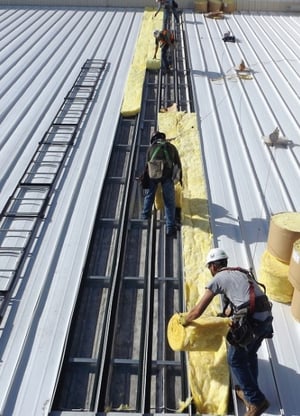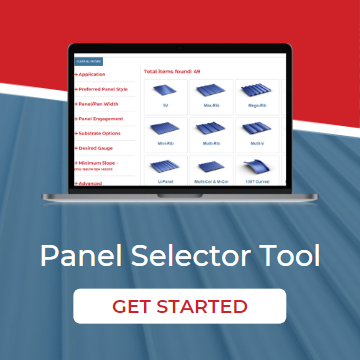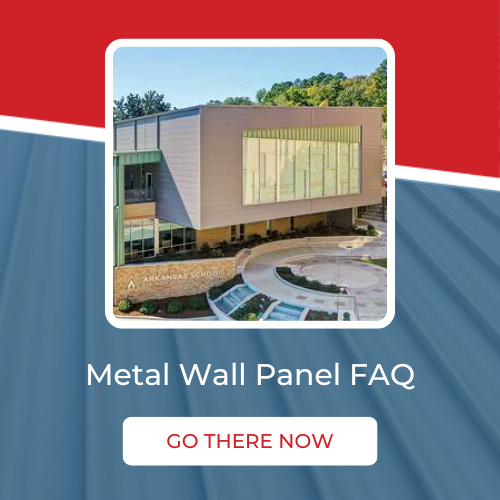Posted by McElroy Metal ● Jul 23, 2019 7:00 AM
Commercial Roofing Materials: Membrane versus Metal Roofing
Membrane and metal roofing are two of the most common styles of flat and low slope commercial roofing. These commercial roofing materials offer building owners varying degrees of durability, longevity, and performance, so let’s break down the most common types of both.
EPDM Membrane
Ethylene propylene diene monomer (EPDM), also called rubber, or synthetic rubber roofing, has been in use for many decades. As one of the least expensive commercial roofing materials on the market, it is easy to find installers and distributors of EPDM roofing.
EPDM can last up to 20 years, but it is prone to shrinkage, which can lead to water damage as it pulls away at the seams and penetrations especially in high temperature zones. Punctures can also be an issue, especially in hail and storm-prone areas. Typically, EPDM is black, so it also absorbs heat and can contribute to higher utility expenses. EPDM’s are also available with a laminated white layer to provide solar reflectance, but this is a small portion of total squares installed of this product because the white top coat can be less durable and can chalk and fade over time. The majority of EPDM roofs installed are black, but it has become common for a post spray application of a white reflective coatings to meet energy guidelines.
Thermoplastic Materials: PVC and TPO Membrane
Thermoplastic roofing is similar to EPDM roofing in that it is installed in large sheets that are fused together, but where EPDM seams are typically chemically bonded together with a high performance adhesive, thermoplastics are heat-fused. This style of membrane roofing also features a reinforcement layer that adds strength and durability to the sheets.
The two most common thermoplastic roofing materials are thermoplastic polyolefin (TPO) and Polyvinyl chloride (PVC). TPO roofing is more expensive than EPDM but less expensive than the PVC options. With a lifespan of 20-30 years, TPO is a longer lasting opting. TPO is also typically white so, unlike EPDM, it will reflect the sun and is less of a burden on your HVAC system.
TPO, like EPDM and all membrane roofing, is susceptible to punctures and TPO is prone to shrinkage as well, which can again, lead to leaks at penetration, curbs and seams. There is also a lot of variability between TPO manufacturers, which makes it difficult to judge the quality of this product group as a whole. The quality of the formulations and the mil thickness is also an important factor in determining overall performance. Installation techniques are a major contributor to the success or failure of the system.
Polyvinyl chloride (PVC) is also a thermoplastic membrane roofing material. PVC has a lifespan of up to 30 years and is more energy efficient than other membrane options. PVC is also fire resistant and has better resistance to oil and greases and many chemicals. Some brands have done well against punctures especially when the mill thickness is high.
PVC has a higher upfront cost than TPO and can be difficult to repair when needed and does not perform as well as other systems in colder climates. This can be attributed to the benefit of PVC’s chemical resistance, so patch adhesives may not always stick because it is harder. Older PVC roofs have been known to have portions shatter in cold weather from impact or foot traffic, so repairs and walking should be done at warmer temperatures.
Modified Bitumen
Modified bitumen roofing is often black or darker in color so it can increase utility costs. It is also prone to damage and deterioration from ponding water and has one of the shortest lifespans of the membrane roofing materials. Modified bitumen is manufactured from asphalt, rubber modifiers, and solvents and is a type of asphalt roofing. With a lifespan of 12-20 years, modified bitumen features seams that are typically heat sealed. With high tensile strength, modified bitumen roofing is more resistant to puncture and damage than EPDM and thermoplastic materials. It comes in 1, 2 or 3 ply thickness which directly affects longevity.
Metal Roofing

Metal roofing offers building owners an impressive 50+ year lifespan, which is significantly longer than any of the membrane roofing materials on the market. Metal roofing is also naturally resistant to fire, hail, and punctures, which is of particular concern for buildings in storm-prone areas.
Metal roofing is also more energy efficient than other roofing types and, depending on the style of metal roofing and installation methods utilized, allows for the inclusion of a ventilated air space under the panels which can significantly improve on energy efficiency of the system.
One of the perceived downside to metal roofing is that it has a higher upfront cost than any of the membrane roofing materials. But when life cycle cost is considered, it can be one of the most cost efficient systems out there. Lifecycle costs incorporate both the longevity and energy efficiency. While all roofing products require some maintenance from time to time, metal systems are durable and require considerably less. Of course they also come in a wide variety of long lasting colors, as well as Cool Reflective Colors so owners have many more choices in style and design.
Metal Roofing Retrofits

One of the advantages of metal roofing is that it allows building owners to opt for a roofing retrofit rather than a traditional tear-off and replace solution. In fact, when installing a metal roof over an existing flat or low slope roof, the roof slope can even be altered. Moving from a low slope to a steep slope roof eliminates some of the problems inherent in low slope roofing like ponding water and leaks from internal drains and pipe penetrations, and can provide a dramatic change to the aesthetics and energy performance of the building. You can learn more about flat roof retrofits here.
It is important to remember that all systems have their features and drawbacks based on a host of variables, but what should always be considered is the quality of the manufacturer and the quality and workmanship of the installer. The best products can’t perform if not installed correctly. They go hand in hand.
Learn More
Want to learn more about commercial roofing materials, reroofing options, and commercial roofing in general? Subscribe to the Metal Roofing Contractors Blog or contact us here.
About McElroy Metal
Since 1963, McElroy Metal has served the construction industry with quality products and excellent customer service. The employee-owned components manufacturer is headquartered in Bossier City, La., and has 14 manufacturing facilities across the United States. Quality, service and performance have been the cornerstone of McElroy Metal’s business philosophy and have contributed to the success of the company through the years. As a preferred service provider, these values will continue to be at the forefront of McElroy Metal’s model along with a strong focus on the customer.
Topics: Education, Metal Roofing, Recover and Retrofit, Commercial, Architect Resources
Comments on this article:
Scroll down to the bottom to submit a comment and join the conversation. Need help or have a question? Please contact us.











%20(002).png)